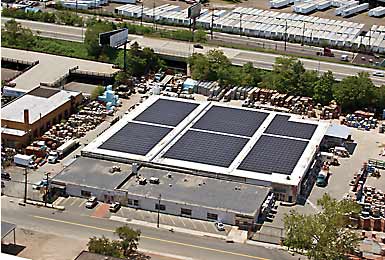The Area Development Frontline series offers insight into successful, innovative strategies taken by businesses; intelligence on locations that are deploying winning policies that attract investment and talent; and reports on industry trends that affect and shape the global business climate now and in the future.
Companies seeking to reduce their carbon footprints - and their bottom lines - can still take advantage of a Treasury Department program that extends cash grants worth 30 percent of an installation to businesses that invest in solar systems. Section 1603, set to expire on December 31, 2010, was renewed for another year. Introduced in the Recovery Act, these grants have encouraged businesses to install solar systems.
California Tops for Solar
California leads the nation with 74,447 solar installations and 747 megawatts installed to date. Molly Sterkel, manager of the California Public Utilities Commission's California Solar Initiative (CSI), says Section 1603 has been instrumental.
"After California's legislature passed a law in the beginning of 2010 clarifying that 1603 grants were not taxable, we saw a large increase in the number of solar rebate application programs," Sterkel says.
CSI offers installers additional cash rebates. "That's definitely been supported by the 1603 grant program," Sterkel says. Businesses have reaped these incentives' benefits. "This tax grant [Section 1603] gives a great option for businesses going solar," says Sue Kateley, California Solar Energy Industries Association (CALSEIA) executive director. "That actually gives a way to make the tax credit program more flexible to business needs."
Borrego Solar, a designer, installer, and financier of photovoltaic systems, has found it difficult to finance solar projects since the recession. But the immediate return on investment Section 1603 offers has allowed the company to proceed on its work and expand its business.
"This extension assures that our industry and our company will grow in 2011," says Borrego CEO Mike Hall. "For Borrego Solar, this extension will likely result in us increasing our full time staff by 30 percent in 2011. In addition, we will be putting a lot more people to work indirectly through our vendor and subcontractor relationships."
New Jersey Invests in Solar Future
Garden State businesses have received a combined $72.2 million in Section 1603 grants towards 164 solar projects worth more than $240 million since the program's inception. Solar installations increased threefold in the state from 2009 to 2011, partly due to the grant.
"Section 1603 makes it even more feasible for building owners to invest in these systems on their own properties," says Jamie Hahn, managing director of Solis Partners in Manasquan.
Due to a state program of 100 percent untaxed bonus depreciation, Hahn says, businesses are realizing payback for installing solar systems in only three to four years.
Extech Building Materials installed a 49,000-square-foot, 300,000-kilowatt solar roof array at its Newark facility in April 2010 that was funded by state and Section 1603 programs. (See the installation in the image above.) "We probably would not have done it without it," says company owner Tim Feury, who called the approximately $1.9 million project "cost-prohibitive" without the programs.
Extech received its Section 1603 rebate within the scheduled 60 days, as well as a $1.1 million loan from state utility PSE&G. The company spent only about $200,000 for the system, and hasn't paid an electric bill since switching to solar, saving up to $80,000 annually. "Economically," Feury says, "it just made sense."
Now, national solar industry groups and other players in the sector are already preparing for another renewal in 2011.




